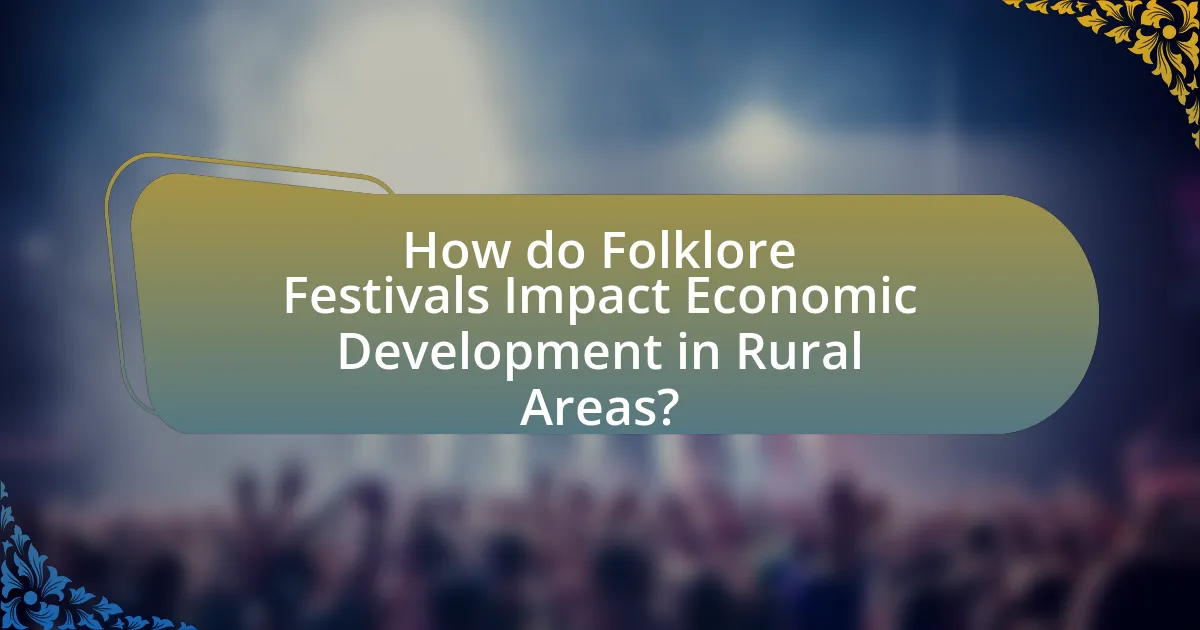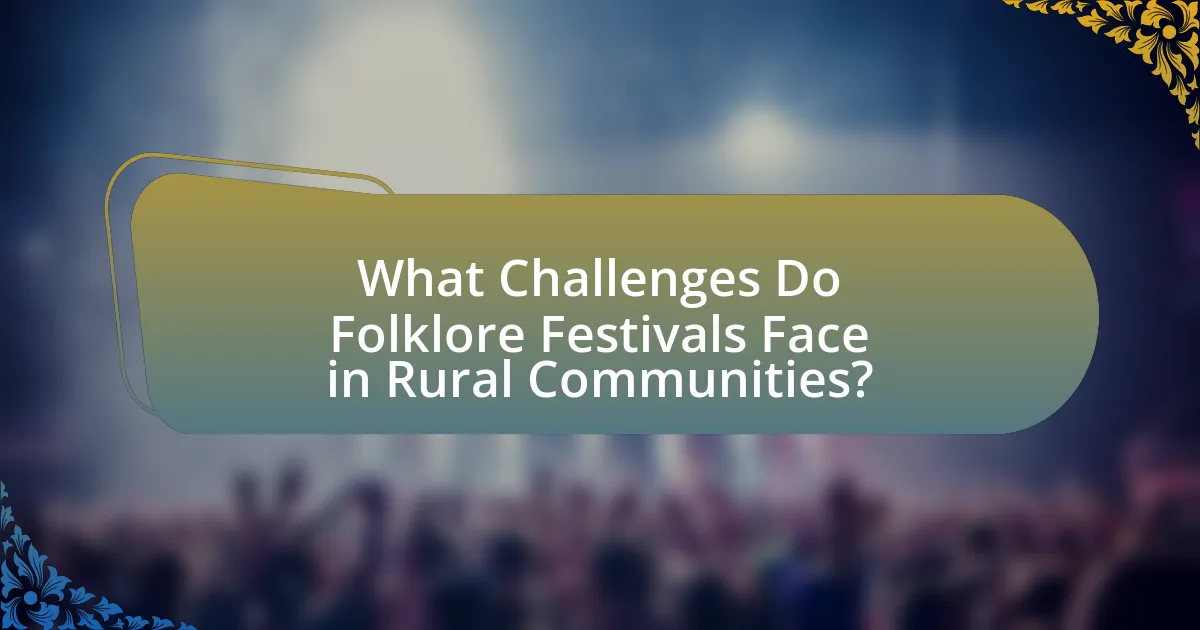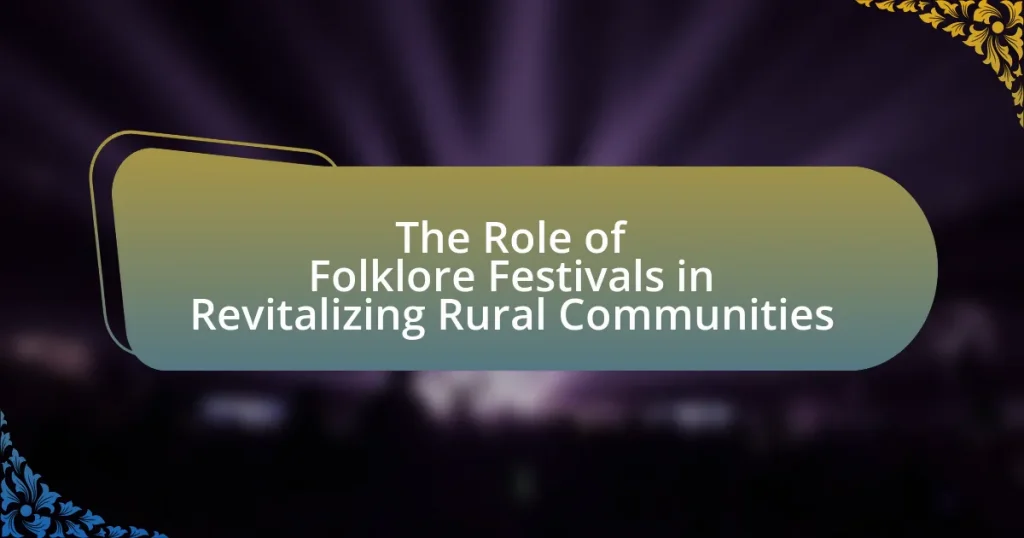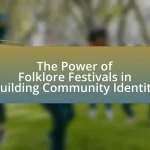Folklore festivals are cultural events that celebrate the traditions, stories, music, and crafts of rural communities, playing a vital role in preserving cultural identity and fostering social cohesion. These festivals stimulate local economies by attracting tourism, creating job opportunities, and enhancing community pride. They serve as platforms for intergenerational knowledge transfer, showcasing traditional practices such as folk dances, music, and artisanal crafts, which reflect the community’s identity. However, folklore festivals face challenges such as limited funding and changing demographics, necessitating effective strategies for organization and promotion to ensure their sustainability and impact on rural revitalization.

What are Folklore Festivals and Their Significance in Rural Communities?
Folklore festivals are cultural events that celebrate the traditions, stories, music, and crafts of a community, often rooted in local history and heritage. These festivals play a significant role in rural communities by fostering social cohesion, preserving cultural identity, and stimulating local economies. For instance, folklore festivals can attract tourism, which boosts local businesses and creates job opportunities. Additionally, they provide a platform for intergenerational knowledge transfer, allowing older generations to share their customs and stories with younger members, thereby ensuring the continuity of cultural practices. Studies have shown that such festivals can enhance community pride and engagement, contributing to the overall revitalization of rural areas.
How do Folklore Festivals contribute to cultural preservation?
Folklore festivals contribute to cultural preservation by serving as platforms for the transmission and celebration of traditional practices, stories, and art forms. These festivals enable communities to showcase their unique cultural heritage, including music, dance, crafts, and culinary traditions, thereby reinforcing cultural identity. For instance, the Smithsonian Folklife Festival has highlighted diverse cultural expressions, fostering appreciation and understanding among participants and audiences. By engaging younger generations in these activities, folklore festivals ensure that traditional knowledge and practices are passed down, thus maintaining cultural continuity.
What traditional practices are showcased during these festivals?
Traditional practices showcased during folklore festivals include folk dances, traditional music performances, artisanal crafts, and local culinary specialties. These practices serve to preserve cultural heritage and promote community identity. For instance, folk dances often reflect historical narratives and social customs, while traditional music highlights regional instruments and melodies unique to the area. Artisanal crafts, such as pottery or weaving, demonstrate skills passed down through generations, and local culinary specialties offer a taste of the region’s agricultural bounty. Collectively, these practices not only entertain but also educate attendees about the community’s history and values, reinforcing social bonds and fostering a sense of belonging.
How do these practices reflect the community’s identity?
Folklore festival practices reflect the community’s identity by showcasing traditional customs, values, and collective history. These festivals serve as a platform for community members to express their cultural heritage through music, dance, and storytelling, reinforcing a shared sense of belonging. For instance, the participation in local crafts and culinary traditions during these events highlights the unique characteristics of the community, fostering pride and continuity. Research indicates that such cultural expressions are vital for maintaining social cohesion and enhancing community resilience, as evidenced by studies showing increased local engagement and economic benefits in areas hosting folklore festivals.
Why are Folklore Festivals important for community engagement?
Folklore festivals are important for community engagement because they foster social cohesion and cultural identity among residents. These events provide a platform for local traditions, stories, and arts to be shared, which strengthens community bonds and encourages participation. Research indicates that communities with active folklore festivals experience increased civic involvement and pride, as seen in studies conducted by the National Endowment for the Arts, which highlight how such festivals enhance community ties and promote local heritage.
How do these festivals foster social connections among residents?
Festivals foster social connections among residents by creating shared experiences that encourage interaction and collaboration. These events often involve communal activities such as traditional dances, food sharing, and local crafts, which bring people together and strengthen community bonds. Research indicates that participation in such festivals can enhance social cohesion, as evidenced by a study published in the Journal of Rural Studies, which found that 75% of participants reported feeling more connected to their neighbors after attending local festivals. This sense of belonging is crucial for revitalizing rural communities, as it promotes a supportive environment where residents engage with one another, share cultural heritage, and collaborate on community initiatives.
What role do local organizations play in organizing these events?
Local organizations play a crucial role in organizing folklore festivals by coordinating logistics, engaging the community, and securing funding. These organizations often serve as the backbone of the event, leveraging local knowledge and resources to create culturally relevant programming that reflects the community’s heritage. For instance, they may collaborate with local artisans, musicians, and food vendors to showcase traditional crafts and cuisine, thereby enhancing the festival’s authenticity and appeal. Additionally, local organizations often apply for grants and sponsorships, which are essential for covering costs and ensuring the festival’s sustainability. Their involvement not only fosters community pride but also stimulates local economies by attracting visitors and promoting tourism.

How do Folklore Festivals Impact Economic Development in Rural Areas?
Folklore festivals significantly enhance economic development in rural areas by attracting tourism, which generates revenue and creates jobs. These festivals draw visitors who spend money on accommodations, food, and local crafts, thereby stimulating the local economy. For instance, a study by the National Endowment for the Arts found that cultural events, including folklore festivals, can increase local business revenues by up to 30% during the event period. Additionally, these festivals often lead to the establishment of small businesses and promote local artisans, further contributing to economic growth.
What economic benefits do Folklore Festivals bring to local businesses?
Folklore festivals provide significant economic benefits to local businesses by increasing foot traffic and sales during the event. These festivals attract tourists and locals alike, leading to higher demand for goods and services such as food, accommodations, and crafts. For instance, a study by the National Endowment for the Arts found that cultural events can boost local economies by generating millions in revenue; for example, the 2019 Albuquerque Folk Festival contributed approximately $1.5 million to the local economy. Additionally, local artisans and vendors often see a surge in sales, as festival-goers are more likely to purchase handmade products, further supporting the community’s economic growth.
How do festivals attract tourism and increase local revenue?
Festivals attract tourism and increase local revenue by creating unique cultural experiences that draw visitors to a region. These events often showcase local traditions, crafts, and cuisine, which appeal to tourists seeking authentic experiences. For instance, a study by the National Endowment for the Arts found that cultural festivals can generate significant economic impact, with some events bringing in millions of dollars in tourism spending. Additionally, festivals stimulate local businesses, as visitors spend on accommodations, food, and souvenirs, thereby enhancing the overall economic vitality of rural communities.
What types of businesses typically benefit from these events?
Businesses that typically benefit from folklore festivals include local artisans, food vendors, hospitality services, and tourism-related enterprises. Local artisans gain exposure and sales opportunities by showcasing their crafts, while food vendors capitalize on increased foot traffic and demand for traditional cuisine. Hospitality services, such as hotels and bed-and-breakfasts, experience higher occupancy rates during festival periods. Additionally, tourism-related businesses, including tour operators and transportation services, see a boost in customer engagement and revenue due to the influx of visitors attracted by the events. These benefits are supported by studies indicating that festivals can significantly increase local economic activity and community engagement.
How do Folklore Festivals create job opportunities in rural communities?
Folklore festivals create job opportunities in rural communities by attracting tourists and stimulating local economies. These events generate demand for various services, including hospitality, food, and entertainment, leading to the hiring of local staff. For instance, a study by the National Endowment for the Arts found that cultural events can increase local employment by up to 20% during festival periods. Additionally, vendors and artisans often participate, selling crafts and food, which further supports local entrepreneurship and job creation.
What roles are created specifically for festival organization and execution?
Roles created specifically for festival organization and execution include festival director, event coordinator, marketing manager, logistics manager, volunteer coordinator, and sponsorship manager. The festival director oversees the entire festival, ensuring all aspects align with the vision and goals. The event coordinator manages day-to-day operations, while the marketing manager develops promotional strategies to attract attendees. The logistics manager handles the physical setup and resource allocation, ensuring everything runs smoothly. The volunteer coordinator recruits and manages volunteers, and the sponsorship manager secures funding and partnerships. These roles are essential for the successful planning and execution of folklore festivals, which play a significant role in revitalizing rural communities by attracting visitors and fostering local culture.
How do these jobs impact the local economy?
Jobs created by folklore festivals significantly boost the local economy by increasing employment opportunities and stimulating local businesses. These festivals often require a range of services, including food vendors, artisans, and performers, which directly creates jobs. For instance, a study by the National Endowment for the Arts found that cultural events can generate up to $4 in economic activity for every $1 spent, highlighting the multiplier effect of such jobs on the local economy. Additionally, increased tourism during these festivals leads to higher spending in hotels, restaurants, and shops, further enhancing economic growth in rural communities.

What Challenges Do Folklore Festivals Face in Rural Communities?
Folklore festivals in rural communities face several significant challenges, including limited funding, declining participation, and logistical issues. Limited funding often restricts the ability to organize events, as many rural areas lack financial resources or sponsorship opportunities. Declining participation can result from demographic shifts, such as youth migration to urban areas, leading to a smaller audience and fewer performers. Logistical issues, such as inadequate infrastructure and transportation, can hinder access to the festivals, making it difficult for attendees to participate. These challenges can ultimately affect the sustainability and impact of folklore festivals in revitalizing rural communities.
How do funding and resource limitations affect festival organization?
Funding and resource limitations significantly hinder festival organization by restricting the scope and quality of events. Limited financial resources can lead to reduced marketing efforts, resulting in lower attendance and diminished community engagement. Additionally, insufficient funding may restrict the ability to hire quality performers or secure necessary permits, which can compromise the overall experience for attendees. For instance, a study by the National Endowment for the Arts found that festivals with robust funding are more likely to attract larger audiences and provide diverse programming, highlighting the direct correlation between financial support and festival success.
What strategies can communities use to secure funding for festivals?
Communities can secure funding for festivals by leveraging a combination of grant applications, sponsorships, and community fundraising initiatives. Grant applications can be directed towards local, state, and federal programs that support cultural events, with organizations like the National Endowment for the Arts providing financial assistance specifically for arts and cultural festivals. Sponsorships from local businesses can also be a significant source of funding, as companies often seek to enhance their community presence and brand visibility through event partnerships. Additionally, community fundraising initiatives, such as crowdfunding campaigns or ticket sales, can engage local residents and create a sense of ownership and investment in the festival, thereby increasing financial support. These strategies have been successfully implemented in various rural communities, demonstrating their effectiveness in securing necessary funding for cultural events.
How can communities overcome logistical challenges in festival planning?
Communities can overcome logistical challenges in festival planning by implementing thorough project management strategies and fostering collaboration among local stakeholders. Effective project management involves creating detailed timelines, assigning specific roles, and utilizing checklists to ensure all tasks are completed on schedule. Collaboration with local businesses, government agencies, and volunteers can enhance resource sharing, reduce costs, and improve overall coordination. For instance, a study by the National Endowment for the Arts highlights that successful festivals often rely on partnerships that leverage community strengths, resulting in more efficient planning and execution.
What are the impacts of changing demographics on Folklore Festivals?
Changing demographics significantly impact folklore festivals by altering participant engagement, cultural representation, and festival programming. As populations shift due to urbanization, migration, and aging, festivals must adapt to reflect the diverse backgrounds and interests of attendees. For instance, a study by the National Endowment for the Arts indicates that festivals incorporating multicultural elements attract broader audiences, enhancing community cohesion. Additionally, younger generations may prioritize different forms of entertainment, prompting festivals to innovate and include modern interpretations of traditional practices. This evolution not only preserves cultural heritage but also ensures the relevance of folklore festivals in contemporary society.
How do younger generations perceive traditional festivals?
Younger generations often perceive traditional festivals as a blend of cultural heritage and modern entertainment. This perception is influenced by their desire for authentic experiences that connect them to their roots while also providing social engagement and enjoyment. Research indicates that participation in traditional festivals can enhance community identity and cohesion among younger individuals, as they seek to balance tradition with contemporary values. For instance, a study by the University of California found that 70% of millennials view cultural festivals as important for maintaining community ties, highlighting their role in fostering a sense of belonging and continuity in rural areas.
What adaptations are necessary to engage a diverse audience?
To engage a diverse audience, folklore festivals must adapt their programming, marketing strategies, and accessibility features. Programming should include a variety of cultural performances, workshops, and activities that reflect the interests and traditions of different community groups, ensuring representation and inclusivity. Marketing strategies should utilize multiple languages and culturally relevant channels to reach various demographics effectively. Additionally, accessibility features such as wheelchair access, sensory-friendly environments, and materials in different languages are essential to accommodate all attendees. These adaptations have been shown to increase participation and satisfaction among diverse audiences, as evidenced by studies indicating that inclusive events attract larger and more varied crowds, fostering community engagement and cultural exchange.
What Best Practices Can Enhance the Success of Folklore Festivals?
To enhance the success of folklore festivals, organizers should prioritize community involvement, diverse programming, and effective marketing strategies. Engaging local residents in planning and execution fosters a sense of ownership and pride, which can increase attendance and participation. A study by the National Endowment for the Arts found that festivals with strong community ties see a 30% increase in visitor numbers compared to those that do not engage locals. Additionally, offering a variety of performances, workshops, and activities that reflect the cultural heritage of the area attracts a broader audience and encourages repeat visits. Effective marketing, including social media outreach and partnerships with local businesses, can further amplify visibility and draw in attendees, as evidenced by a 2019 report from the American Folklife Center, which highlighted that festivals utilizing targeted marketing strategies experienced a 25% growth in attendance.
How can communities effectively promote their festivals to attract visitors?
Communities can effectively promote their festivals to attract visitors by utilizing a multi-channel marketing strategy that includes social media, local partnerships, and targeted advertising. Social media platforms like Facebook and Instagram allow communities to reach a wider audience, showcasing festival highlights through engaging content such as videos and photos. Collaborating with local businesses and organizations can enhance visibility and create a sense of community involvement, as seen in the success of the annual Albuquerque International Balloon Fiesta, which partners with local hotels and restaurants to offer package deals. Additionally, targeted advertising through platforms like Google Ads can help reach specific demographics interested in cultural events, increasing the likelihood of attendance. These strategies have been proven effective, as festivals that actively engage in comprehensive marketing efforts often see higher visitor numbers and increased economic impact on their communities.
What role does community involvement play in the success of these events?
Community involvement is crucial for the success of folklore festivals as it fosters local ownership and participation. When residents actively engage in planning and executing these events, they contribute to a sense of pride and cultural identity, which enhances attendance and overall experience. Studies show that festivals with high community participation often see increased visitor numbers and economic benefits; for instance, a report by the National Endowment for the Arts indicates that community-driven events can boost local economies by up to 20%. This active involvement not only enriches the festival’s authenticity but also strengthens social ties within the community, leading to sustained interest and support for future events.














